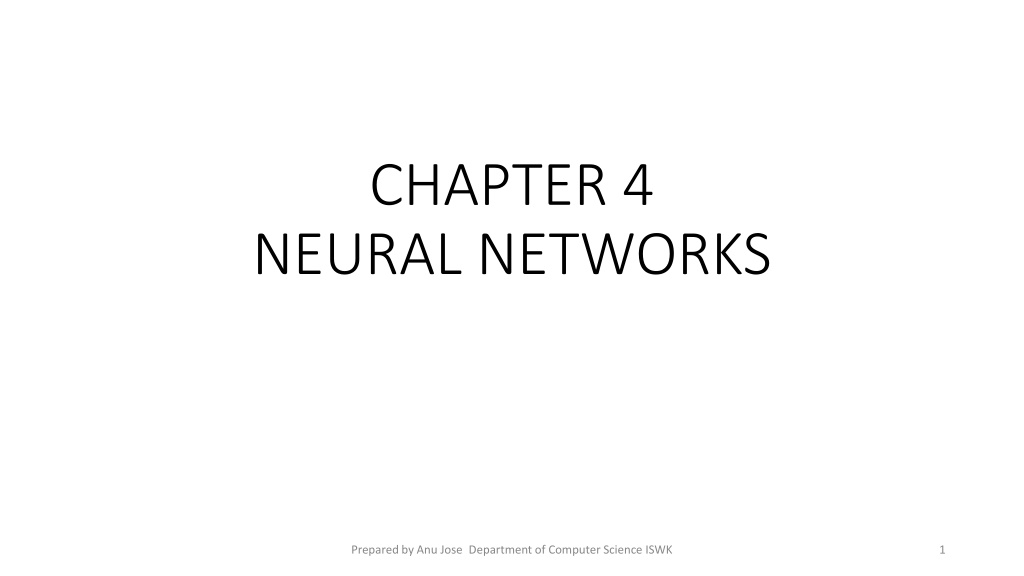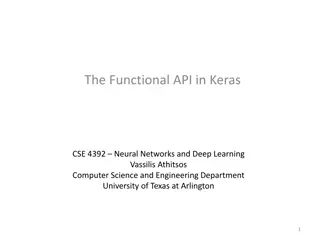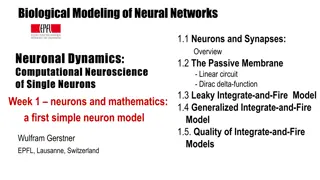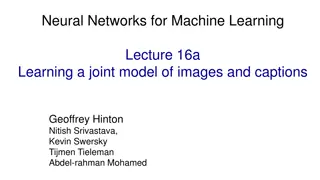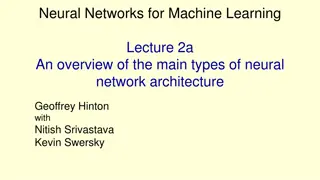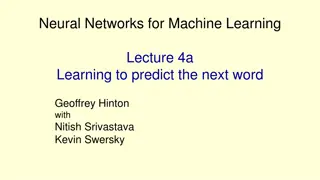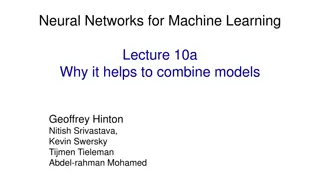Understanding Neural Networks: Models and Approaches in AI
Neural networks play a crucial role in AI with rule-based and machine learning approaches. Rule-based learning involves feeding data and rules to the model for predictions, while machine learning allows the machine to design algorithms based on input data and answers. Common AI models include Regression, Classification, and Clustering. Regression predicts continuous data, classification sorts labeled datasets, and clustering groups data points. Each model has unique functions and uses in AI development.
Download Presentation

Please find below an Image/Link to download the presentation.
The content on the website is provided AS IS for your information and personal use only. It may not be sold, licensed, or shared on other websites without obtaining consent from the author. Download presentation by click this link. If you encounter any issues during the download, it is possible that the publisher has removed the file from their server.
E N D
Presentation Transcript
CHAPTER 4 NEURAL NETWORKS Prepared by Anu Jose Department of Computer Science ISWK 1
Modelling Prepared by Anu Jose Department of Computer Science ISWK 2
Rule Base learning Rule based approach, the developer feeds in data along with some ground rules to the model. The model gets trained with these inputs and gives out answers in the form of predictions. This approach is commonly used when we have a known dataset or labelled dataset. Prepared by Anu Jose Department of Computer Science ISWK 3
Machine learning Machine Learning approach the developer feeds in data along with the answers. The machine then designs its own algorithms and methodologies to match the data with answers and gives out the rules. This approach is commonly used when the data is unknown/random or unlabelled. Prepared by Anu Jose Department of Computer Science ISWK 4
Common AI models Are Regression Classification Clustering Prepared by Anu Jose Department of Computer Science ISWK 5
REGRESSION: This is a type of Rule based AI model. In regression, the algorithm generates a mapping function from the given data, represented by the solid line. The blue dots shown in the graph are the data values and the solid line here represents the mapping done for them. With the help of this mapping function, we can predict the future data. For example, if we want to predict the salary of an employee, we can use his past salaries as training data and can predict his next salary. Regression works with continuous data. Prepared by Anu Jose Department of Computer Science ISWK 6
Classification - This is a rule based AI model In classification, the algorithm is able to determine which set a given data point belongs to by means of a classification function represented by the dotted line. The model classifies datasets according to the rules given to it. Usually the dataset used for classification are labelled and the data then gets sorted according to their labelling. Testing data is then classified as one of the labels of the training dataset. For example, If we want to train a model to identify if an image is of a guitar or a piano, we need to train it with multiple images of both guitar and piano along with their labels. The machine will then classify images on the basis of the labels and predict the correct label for testing data. Classification works on discrete dataset.. Prepared by Anu Jose Department of Computer Science ISWK 7
CLUSTERING: This is a Machine learning approach where the machine generates its own rules or algorithms to differentiate amongst the given dataset to achieve the pre-decided goal. The data fed to such a model is usually unlabelled or random and thus the developer feeds in the data directly into the machine and instructs it to build its own algorithm. The machine then finds out patterns or trends out of the training dataset and clusters the ones which follow the same pattern. The output rules might be very different to what was expected as the machine has its own way of recognising patterns. For example, if you have a random data of stray dogs which live in your locality, since you are unable to find any meaningful pattern amongst them, you would feed their data into the clustering algorithm. The algorithm would then analyse the data and divide them into clusters according to their similarities based on the trends noticed. The clusters are then given as the output. Clustering works on discrete dataset. Prepared by Anu Jose Department of Computer Science ISWK 8
Neural Networks-Definition Neural networks are loosely modelled after how neurons in the human brain behave. The key advantage of neural networks are that they are able to extract data features automatically without needing the input of the programmer. A neural network is essentially a system of organizing machine learning algorithms to perform certain tasks. It is a fast and efficient way to solve problems for which the dataset is very large, such as in images. Prepared by Anu Jose Department of Computer Science ISWK 10
As seen in the figure given, the larger Neural Networks tend to perform better with larger amounts of data whereas the traditional machine learning algorithms stop improving after a certain saturation point. Prepared by Anu Jose Department of Computer Science ISWK 11
Neural Network structure Prepared by Anu Jose Department of Computer Science ISWK 12
This is a representation of how neural networks work. A Neural Network is divided into multiple layers and each layer is further divided into several blocks called nodes. Each node has its own task to accomplish which is then passed to the next layer. The first layer of a Neural Network is known as the input layer. The job of an input layer is to acquire data and feed it to the Neural Network. No processing occurs at the input layer. Next to it, are the hidden layers. Hidden layers are the layers in which the whole processing occurs. Their name essentially means that these layers are hidden and are not visible to the user. Each node of these hidden layers has its own machine learning algorithm which it executes on the data received from the input layer. The processed output is then fed to the subsequent hidden layer of the network. There can be multiple hidden layers in a neural network system and their number depends upon the complexity of the function for which the network has been configured. Also, the number of nodes in each layer can vary accordingly. The last hidden layer passes the final processed data to the output layer which then gives it to the user as the final output. Similar to the input layer, output layer too does not process the data which it acquires. It is meant for user-interface. Prepared by Anu Jose Department of Computer Science ISWK 13
Neural network features Prepared by Anu Jose Department of Computer Science ISWK 14
Neural Networks Vs Human Nervous System Neural Networks Vs Human Nervous System Prepared by Anu Jose Department of Computer Science ISWK 15
Neural Networks Vs Human Nervous System Neural Networks Vs Human Nervous System Given are the images of a Human Neuron and its relation with the Neural Network. The axon from a neuron sends an impulse to the synapse of another neuron. The impulse received is then sent to the cell body (nucleus) through dendrites. The cell body performs an activation function on the impulse received and then gives it to the output axon which passes the same to the next neuron in the system. Now as we relate this process with an Artificial Neural Network, we can see that the input layer gets data which is passes on to the nodes in the hidden layer. The nodes perform specific actions on the data and pass the processed information to the next layer. In the end, the final processed data reaches the output of the system. Prepared by Anu Jose Department of Computer Science ISWK 16
Neural Networks Vs Human Nervous System Neural Networks Vs Human Nervous System Prepared by Anu Jose Department of Computer Science ISWK17
